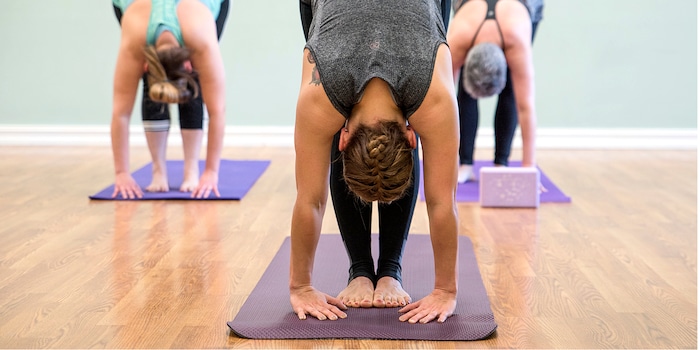

Yoga mats: a balancing act between health and planet
New Year’s resolutions seem a distant figment of the imagination now, don’t they? It’s not long before stressful life in a bustling city takes hold. What was it we’d committed to change again? Something to do with eating better, shopping sustainably and treating our bodies like a temple so we look after them more.
I admit I have neglected the latter somewhat. My yoga course finished so long ago that I can hardly remember any of the poses. So it’s definitely high time I give my temple a bit of a spring clean. My yoga mat has also seen better days and now gets used for other things. That’s why I had to buy myself a new one – except this time, I did it with a clear conscience.
What do you need from your yoga mat?
Given that we’re living in a time of overconsumption and crazy health fads, the most important thing for me is that my yoga mat is sustainable. So obviously, I start to scour the Internet for my options. Rather than a few clear results, I’m met with some confusion. But one thing is certain: sustainability is a vague term and it can be interpreted in a number of ways. For instance, a lot of manufacturers seem to be referring to a different definition to the one I use. To be clear, my ideal concept of sustainable is when a product is 100% recyclable or biodegradable. I want to minimise my carbon footprint. It’s really a no-brainer when you think yoga is all about preaching balance.
Amid a sea of mats
Even the slightest bit of research shows there are about as many yoga mats as grains of sand on the beach. And they tick every possible box on a yogi’s list. They’re non-slip, light, thin, easy to wash and the list goes on. They come in about 1,000 different colours (OK, slight exaggeration) and they don’t break the bank. But what are we actually stretching on? Most mats are made of PVC or have a high PVC content. It goes without saying this is anything but environmentally friendly and in fact bad for our own health.
A quick crash course on all things PVC
PVC is one of the cheap wonder materials that’s been made by the modern world. It’s an amorphous,
synthetic thermoplastic that can be found almost everywhere, from doors to windows to give just a few examples. But in order to turn a hard plastic into a soft yoga mat, some manufacturers use harmful softeners or plasticisers, such as dioctyl phthalate (DOP), which we then absorb directly through our sweaty skin.
Bright but not so beautiful
What’s more, you often find that brightly coloured PVC mats contain azo dyes, which have been proven to be harmful to your health. The bad news is, these PVC things are the classics when it comes to non-slip mats. This is not least because there haven’t really been viable alternatives for years. Unfortunately, time has shown that PVC yoga mats will only be proverbially rotting on the scrapheap. Given their make-up, they can’t actually decompose themselves or be replaced with microorganisms. And burning them releases carcinogenic dioxins. This actually occurs as early on as the production process when chlorine is used. The toxins that are then released into the water and air harm both people and the planet.

The paradox
The thing is, yogis are often quite mindful about what they buy. That’s why a lot of manufacturers intentionally lack transparency on the exact plastic composition of their yoga mats. Or they drop the word «sustainable» but you can’t work out exactly what is so sustainable about the product. Often the brand name itself is lauded as a sign of quality.
Eco yoga mat alternatives
Hallelujah. Against the backdrop of growing awareness of health and environmental impacts, a few smart thinkers launched safe alternatives made of cotton and natural rubber. I’ve created a roundup of the best alternatives so you can see them at a glance – they’ll keep your sustainability conscience clear as well:
JadeYoga mats
The American brand JadeYoga focuses mostly on reuse and reduction. The company makes vegan yoga mats made of natural rubber. This naturally growing raw material is biodegradable and free from plastic and any plasticisers or softeners. The material’s open cell structure is designed to be non-slip even if it’s hot or if you’re sweaty. On top of that, JadeYoga also run a giveback scheme where you can return your used yoga mats. (20% of the Encore range gets recycled.) Meanwhile, yoga mats that are still useable get donated to non-profit organisations. What’s more, you’re planting a tree with every mat you buy. That gets the folded hand emoji from me 🙏.

Manduka yoga mats
Another vegan yoga mat brand is Manduka’s EKO range. The company teamed up with yoga teachers to make sure they created something that was just right. Made of natural rubber, cotton and recycled silk, these mats are 100% biodegradable and completely nasties-free. The US brand takes inspiration from the zero-waste movement in their transparent approach to the production process. And it’s their policy not to release any waste or pollutants into the atmosphere.
Organic cotton yoga mats
The classic Indian mats are starting to catch on in the West as well. When you’re travelling, this kind of mat is practical and easy to carry. You can now get some yoga mats that are made of a cotton-natural fibre mixture, such as cotton combined with natural rubber or natural latex to create a non-slip surface. If you do opt for a cotton mat, here are the main things you want to look out for. 1. Make sure it is organic cotton and Öko Tex 100 standard so you know it doesn’t contain any pesticides or other harmful substances. 2. If you’re interested in social ethics and not just the health aspect of things, look out for a mat with a fair trade symbol. Pranajaya mats, for instance, are made of 100% pure, certified organic cotton and are rubber- and PVC-free.
The difference really is in the detail
Even when you’re buying something supposedly small like a yoga mat, it’s not always easy to be a good person or an ethical consumer. But it is possible. Even if that means you have to dig a bit deeper into your pocket – it’s always worth it. And in fact, I think it feels good to be able to dream of green meadows on your yoga mat with a clear conscience. This just goes to show that not all New Year’s resolutions are a lost cause.
When I'm not distracted by a dog on the street because I'm dying to pet it and otherwise very much in love with animals and board sports, I try to understand, enjoy, question and always remain curious about the world around us. My camera is usually with me so that no story, daydream or moment goes to waste.



